|
This is the second part of the story of the 8´ gaff
sloop Grace O'Malley. The birth of the vessel in question was described
earlier in 2002 in the first part of the story called
“Grace O`Malley will sail again”.
June 1st
06:00
|
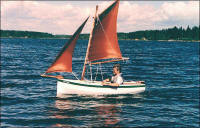
click pictures to
enlarge |
I woke up, and knew at once that there was no point in trying to go to
sleep again. The day had finally arrived. More than 20 months after the
first sketches it was time for the water-test. I got up and looked out
through the kitchen window. A beautiful warm summer day! The trees were
not moving at all. Dead calm. Then I looked at the trees further away by
the garage. They were moving a lot. Unpredictable wind conditions.
07:30
I fetched the car and started loading: bowsprit, mast
and sail, rudder, paddle, centreboard, wetsuit, camera and a bag with dry
clothes.
08:00
My friend Tapio arrived with his son Viktor, the
selected audience. Together we carried the hull from our living-room to
the elevator (where she fits with a small margin) and further to the
car-roof.
08:20
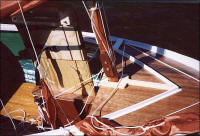 Arrived at the lake. The whole area more or less deserted, a westerly
force 1-2, the sun shining. Everything looked perfect. We put her in the
water and started rigging her. During the winter I had carefully planned
the way all the lines would go, but in the heat of the moment I forgot
what I had decided and the lines went in more at random. That was not
important, I could easily follow the lines to see where they went.
The water was still slightly below bathing temperature so I had brought my
old wet-suit. When I said something about putting it on Tapio said: No,
you wont need that. So I didn’t.
Arrived at the lake. The whole area more or less deserted, a westerly
force 1-2, the sun shining. Everything looked perfect. We put her in the
water and started rigging her. During the winter I had carefully planned
the way all the lines would go, but in the heat of the moment I forgot
what I had decided and the lines went in more at random. That was not
important, I could easily follow the lines to see where they went.
The water was still slightly below bathing temperature so I had brought my
old wet-suit. When I said something about putting it on Tapio said: No,
you wont need that. So I didn’t.
08:45
The moment of truth had arrived. She seemed rather
tender with the board up and Tapio had to hold the hull as I went in.
The lake is very shallow and I had attached a 20cm/8” draught limiter to
the board, reducing it from the rather over-ambitious 90 cm/3´ it is
supposed to be. I managed to raise the sails and she started to move very
slowly. But she moved forward! Success number 1. The main did not stand
well at all, as I was unable to tension the gaff. I had a line attached to
the gaff in two points, and had intended to tie a knot in that line to
have a fixed point to secure the halyard to. But that was another thing I
had forgotten to do. Then I noticed that I was not going in a straight
line at all, but rather in zig-zag. Steering by line worked well, but
every time some other line caught my attention I lost control of the
rudder angle and as I could not see the thing only the changing course
could reveal that something was wrong. After a few minutes I felt more and
more in control and made some rather elegant but slow tacks along the
beach.
08:50
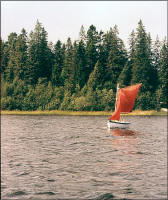 THUMP! The
centreboard ran into what felt like a big rock. I pulled the halyard I
remembered as the board-raiser. Nothing happened. I tried to follow the
line in question to see where it went, but lost it among the mass of lines
half-way up the mast. I pulled the line that was the second most likely
with the same result. The lines had obviously jammed in the mast-top. At
that moment the wind suddenly picked up to a force 3-4, and the boat
started to move sideways. THUMP, THUMP, THUMP. I was entering an entire
area of submerged rocks. I decided to lower the main to get some time to
think. I released the line, but nothing happened. The gaff line had also
jammed in the mast top. At this moment I could easily have started to feel
stress if there had been say 50 persons on the beach watching, but the
precaution to be out early a Sunday morning paid off and I eventually
managed to paddle myself out of the spot when the wind dropped. All the
desperate pulling in lines had left the gaff more or less horizontal so
there was no point in continuing to sail. As I approached the launching
spot I had to lift the board with my bare hands to get in to shallow
waters. Not the best ergonomical position to lift a lot of iron, but to
try to abandon ship in waist-deep water would lead to a capsize so I had
no choice. THUMP! The
centreboard ran into what felt like a big rock. I pulled the halyard I
remembered as the board-raiser. Nothing happened. I tried to follow the
line in question to see where it went, but lost it among the mass of lines
half-way up the mast. I pulled the line that was the second most likely
with the same result. The lines had obviously jammed in the mast-top. At
that moment the wind suddenly picked up to a force 3-4, and the boat
started to move sideways. THUMP, THUMP, THUMP. I was entering an entire
area of submerged rocks. I decided to lower the main to get some time to
think. I released the line, but nothing happened. The gaff line had also
jammed in the mast top. At this moment I could easily have started to feel
stress if there had been say 50 persons on the beach watching, but the
precaution to be out early a Sunday morning paid off and I eventually
managed to paddle myself out of the spot when the wind dropped. All the
desperate pulling in lines had left the gaff more or less horizontal so
there was no point in continuing to sail. As I approached the launching
spot I had to lift the board with my bare hands to get in to shallow
waters. Not the best ergonomical position to lift a lot of iron, but to
try to abandon ship in waist-deep water would lead to a capsize so I had
no choice.
Then came a period of improvements. Among those were
the blocks. All the eight blocks I needed to control the rig were
incorporated in the mast, four at the top and four above the deck. I had
made the pulley wheels of wood myself. As I drilled the holes, I got some
of them slightly off-center which was enough for them to start making
trouble as soon as they had the chance. Now I ordered eight small plastic
pulley wheels for a total of 25$, about the same as complete blocks with
those same pulley wheels would have cost.
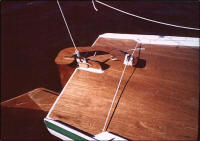 Due to
other commitments the next chance to try out the improvements did not come
until several weeks later. This time I was done with shallow lakes, and
went straight for the sea instead, the Bothnian Sea to be more precise.
Another friend has a summer house on a small island by the coast some 15km
southeast of the city of Umeå. The mission: To get to the island
unaided. This may sound like a big adventure, but the island is less then
300 metres away from the mainland so it isn’t. Rigging involved the
usual problems to sort out all the lines but this time I bothered to use
some logic in their placement. Since last try I had attached two separate
lines to the yard, one close to the mast and one further out. These went
to the two left blocks and gave me a possibility to adjust the angle of
the yard to optimize the shape of the main. On the right I had the jib
halyard on the upper and the centreboard raising on the lower block. Due to
other commitments the next chance to try out the improvements did not come
until several weeks later. This time I was done with shallow lakes, and
went straight for the sea instead, the Bothnian Sea to be more precise.
Another friend has a summer house on a small island by the coast some 15km
southeast of the city of Umeå. The mission: To get to the island
unaided. This may sound like a big adventure, but the island is less then
300 metres away from the mainland so it isn’t. Rigging involved the
usual problems to sort out all the lines but this time I bothered to use
some logic in their placement. Since last try I had attached two separate
lines to the yard, one close to the mast and one further out. These went
to the two left blocks and gave me a possibility to adjust the angle of
the yard to optimize the shape of the main. On the right I had the jib
halyard on the upper and the centreboard raising on the lower block.
The wind had been a force 5 with 6 in the gusts for
several days, but this day the forecast had promised a moderate force 3.
And as I set out it probably was. But only minutes later it began picking
up and soon it almost resembled the preceding days. AND EVERYTHING WORKED
BEAUTIFULLY! She could tack, beat against the wind and above all, she felt
stiff and safe and was fun to sail. The feeling of pure happiness I felt
can hardly be described. It took more than a year and a half of
designing, building and waiting to get to this point but you don’t have to
ask if it was worth it. She felt in fact stiffer than my water ballasted
20’ trailer sailer and there was really little need to shift the body
weight at all. Imagine that eight kilos at the tip of the centreboard can
do so much.
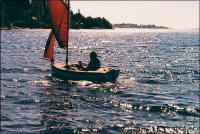 My friend, who
is a much more experienced sailor than me also tried her and commented
that I seemed to have got the calculations fairly right. Wow. Of course
there were still some minor problems with the rope steering and the
centreboard jammed (swelling because of the water?) but nothing could
obscure the fact that the day was a huge success. My friend, who
is a much more experienced sailor than me also tried her and commented
that I seemed to have got the calculations fairly right. Wow. Of course
there were still some minor problems with the rope steering and the
centreboard jammed (swelling because of the water?) but nothing could
obscure the fact that the day was a huge success.
During the building process I had decided there would
have to be a Grace II, where I would incorporate all the improvements in
design and building technique I could come up with on the way. As the
improved Grace started to take shape in my mind, I began to realize that
this new design was evolving into something of a rather unique concept, or
what would you say about a boat that meets the following criteria:
-
That fits against the living room wall when not in
use (leaving the garage to the car).
-
That can be handled and car-topped by one person
(weight target 50-55 lbs.)
-
That has enough foam flotation to be unsinkable in
any event.
-
That has a water-tight storage compartment to
function as a dayboat.
-
That is self-righting after a knock-down (depending
somewhat on the weight distribution of the captains body; I am
considering a seating position where the helmsman is half laying down
with only head and shoulders protruding above the hull).
-
That has a detachable bulbed steelplate centreboard
that can swing back beneath the hull.
-
That (if the builder so wishes) could be built with
a very tight cockpit, meaning that a swamping would never jeopardize
stability and bailing would be easy.
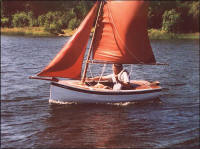 I may
also consider a stretched version for greater waterlength and possibly two
persons (spoiling the first two points). I may
also consider a stretched version for greater waterlength and possibly two
persons (spoiling the first two points).
Just having written all that I discovered the site of
the Minuet Yachts in the UK,
https://www.minuetyachts.com , where they manufacture “The
Minuet Pocket Yacht, a new concept in Sailing” a factory-made boat
of a similar concept but slightly smaller and without the traditional
looks.
Anyway, Grace II will be something more than the toy
the original concept aimed at but rather a pretty, stable, seaworthy
miniature daysailer for one person that does not need any extra storing
place, but rather transforms into a peace of furniture when not in the
water. Design work will start when winter forces me back ashore.
Christer Byström |